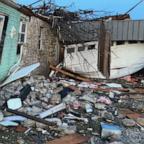Ticking Time Bomb in Your Neighborhood?
Wednesday's explosions in Dallas highlight the dangers of chemical facilities.
July 26, 2007 — -- For Dallas residents it seemed like the end of the world: stacks of highly flammable gas cylinders exploding, one after the other.
Wednesday, a series of explosions at the Southwest Industrial Gases Facility sent flaming debris raining onto highways and buildings near downtown Dallas, seriously injuring at least three people.
"Propane tanks were flying. Everywhere there was fire," Dallas resident Janiqua Bell told "Good Morning America."
Authorities evacuated a half-mile area surrounding the facility and shut down parts of nearby Interstates 30 and 35. Video captured near Southwest Industrial Gases showed numerous small fires burning in the area as stacks of gas cylinders caught fire and exploded.
Now, as fire crews and federal investigators sift through the charred wreckage, some are wondering why a chemical storage facility was built in the heart of a major city, and why so few residents knew it existed.
"When an event occurs, that sometimes is the first time people know there is actually a chemical operation in their neighborhood," said Carolyn Merritt of the U.S. Chemical Safety Board.
The Environmental Protection Agency estimates there are 123 chemical facilities nationwide. Each one of them could put up to 1 million residents at risk.
Beyond these large plants, there are smaller facilities that can also be dangerous. In October 2006, terrified residents in Apex, N.C., fled their homes as thunderous explosions from a much smaller industrial waste plant filled the night sky with an eerie yellow haze of chemical poison.
And in 2005, a deadly chemical train derailment in Granetville, S.C., showed how hazardous chemicals can become when they're traveling through neighborhoods.
"I absolutely thought I pulled my eyelashes off," said Maggie Adams, who survived the derailment. "It burnt so bad."




